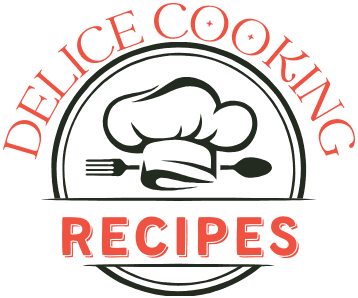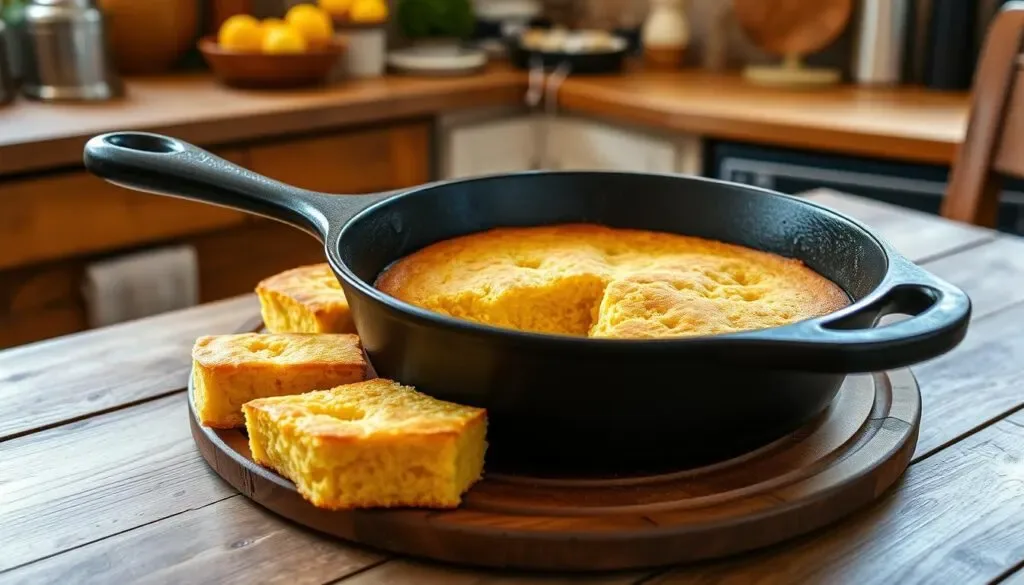Mastering the art of classic Southern cornbread is about more than just baking—it’s about embracing a beloved culinary tradition. Known for its savory flavor and crumbly texture, this iconic dish has been a mainstay in Southern kitchens for generations. Whether you’re reviving family recipes or exploring new takes on the classic, this cornbread brings warmth and authenticity to any table.
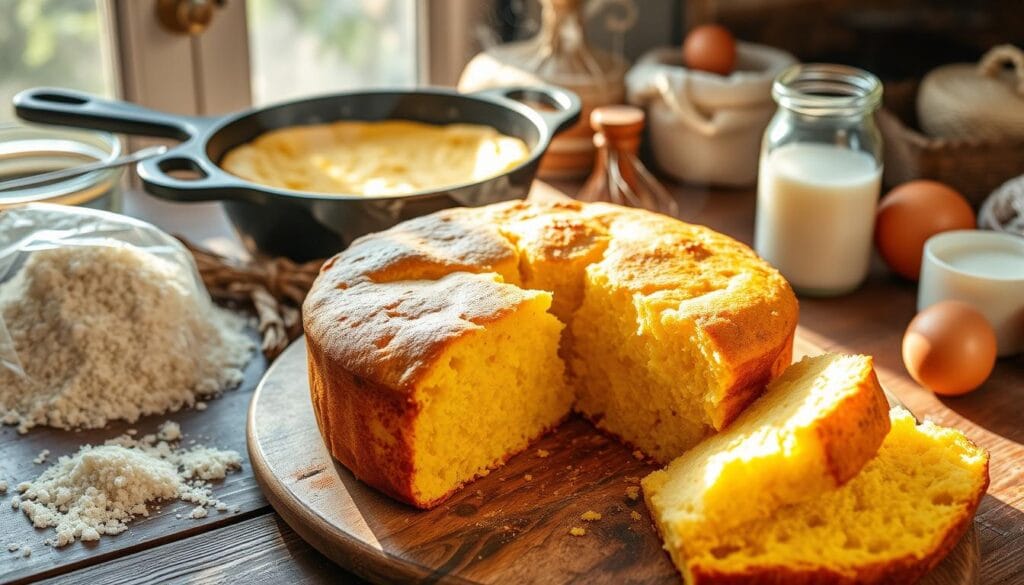
Table of contents
- The History of the Southern Cornbread Recipe
- Understanding Varieties: Southern Cornbread Recipe vs. Northern Cornbread
- What Defines an Authentic Southern Cornbread Recipe?
- Essential Ingredients for the Best Southern Cornbread Recipe
- Choosing the Best Equipment
- Step-by-Step Guide to a Perfect Southern Cornbread Recipe
- Common Mistakes to Avoid When Making a Southern Cornbread Recipe
- Pairing Suggestions for Your Southern Cornbread Recipe
- Storing and Reheating Your Southern Cornbread Recipe
- FAQ
- Conclusion
The History of the Southern Cornbread Recipe
The story of Southern cornbread is rich and deep, rooted in the traditions of Indigenous peoples and early settlers. Over time, this dish has grown to become a cornerstone of Southern cuisine, symbolizing the warmth of Southern hospitality. Its evolution from simple flatbreads to the beloved Southern cornbread we know today reflects both cultural adaptation and culinary tradition.
Origin and Cultural Significance
Before the arrival of European settlers, Native Americans prepared flatbreads from ground corn, known as pone and ash cakes. These early recipes established corn as a vital ingredient in their daily lives and later became integral to Southern cooking. Southern cornbread, however, is more than a staple; it represents comfort, nourishment, and connection. Often served at family meals and celebrations, it even plays a role in the Southern New Year’s tradition, symbolizing wealth and prosperity.
Evolving Recipes Through Generations
Traditional recipes for classic Southern cornbread focus on simplicity, with ingredients like cornmeal, buttermilk, eggs, and salt. Unlike Northern variations, these recipes omit sugar to preserve the corn’s natural flavor. Over generations, local ingredients and personal preferences have inspired modern twists, including the addition of jalapeños, cheese, or even reinventions like cornbread tacos. Despite these variations, the crispy edges from a cast-iron skillet and a moist center remain defining features.
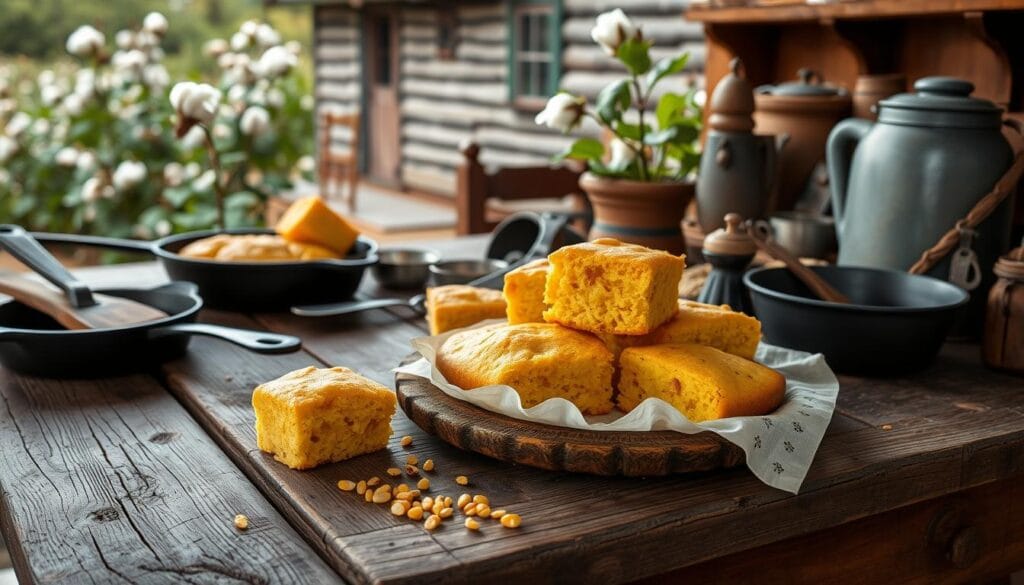
| Feature | Traditional Southern Cornbread | Northern Cornbread |
|---|---|---|
| Texture | Dense and savory | Sweeter and lighter |
| Main Ingredients | Cornmeal, buttermilk, eggs, salt | Cornmeal, sugar, milk, eggs |
| Common Add-ins | Cracklins, jalapeños, cheese | Chocolate, blueberries |
| Cooking Method | Cast-iron skillet for crispy edges | Various baking pans |
| Cultural Associations | Wealth and comfort in Southern meals | Denotes a lighter accompaniment |
Understanding Varieties: Southern Cornbread Recipe vs. Northern Cornbread
Cornbread is a favorite across the United States. But what do they call cornbread in the south? The answer changes with the region, showing different cooking traditions. Northern and Southern cornbread have distinct tastes, textures, and ways of making them.
Differences Between Northern and classic Southern cornbread
Northern and Southern cornbread differ in several ways:
| Characteristic | Northern Cornbread | Southern Cornbread |
|---|---|---|
| Texture | Cake-like, fluffy | Coarse, dense |
| Flavor | Sweet | Savory, no sugar |
| Main Ingredients | More flour and sugar | Buttermilk and bacon grease |
| Cooking Method | Baking in various pans | Typically baked in cast iron |
Knowing these differences helps us understand the rich history of cornbread in the South. Southern cornbread often uses finer cornmeal, making it denser and moister. It also doesn’t have sugar, which lets the cornmeal’s natural taste shine. This makes it great with savory foods.
Regional Variations Across the South
The South has many creative cornbread types. You might find:
- Seafood cornbread along the Gulf Coast, with fresh seafood.
- Okra cornbread, a fun twist on a Southern favorite.
- Jalapeño cornbread in Texas, adding heat and spice.
- Cheddar cornbread, blending cheese with the classic recipe.
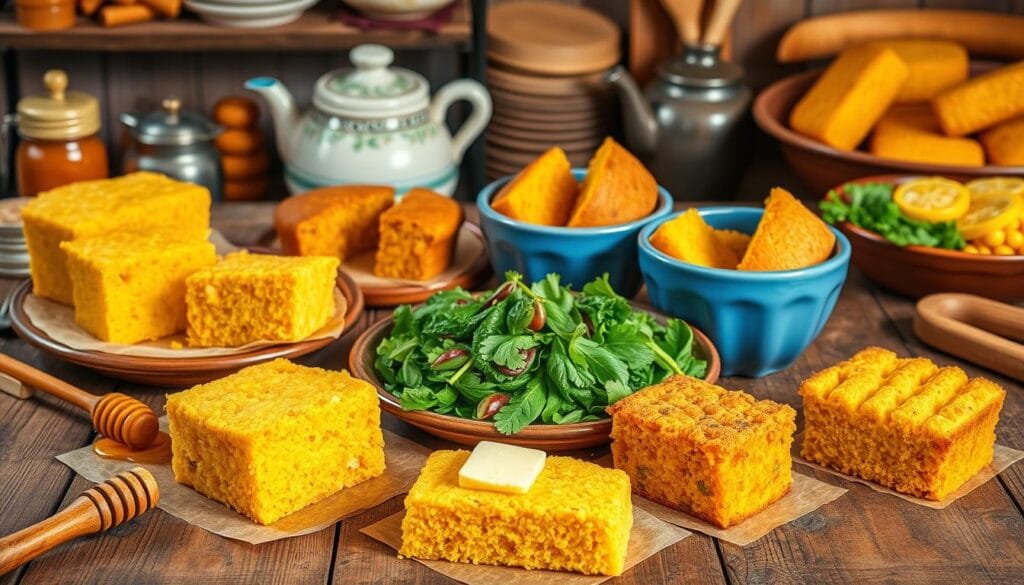
These variations show how different ingredients and cooking styles define each region. Cornbread’s many forms in the South celebrate creativity and heritage in Southern cuisine.
What Defines an Authentic Southern Cornbread Recipe?
The heart of Southern cornbread is in its ingredients and traditional ways. Knowing what makes cornbread authentic is key for that true Southern taste. This dish is unique, with a mix of textures and flavors.
Key Ingredients that Define classic Southern cornbread
To make a real Southern cornbread, focus on these ingredients:
- Stone-ground cornmeal: It’s the base for texture and taste, giving it that crumbly feel.
- Buttermilk: It adds moisture and a tangy taste, and works with baking soda to make it light.
- Bacon grease or butter: It brings a deep, smoky flavor and helps get that crispy crust.
- Eggs: They hold everything together, blending flavors and textures for a great mouthfeel.
Each ingredient is vital for making cornbread right, balancing moisture, taste, and texture in Southern cooking.
Traditional Techniques for Authentic Flavor
Using true Southern cornbread methods makes it even better. Here are some important steps:
- Preheat the cast iron skillet: This method gives a crunchy crust and keeps the cornbread moist.
- Avoid overmixing: Mix ingredients gently to keep it fluffy and let the corn’s natural taste come through.
- Serve warm: Enjoy your cornbread straight from the oven for the best taste.
Learning these steps not only teaches you about cornbread but also improves your cooking skills for this Southern favorite.
Essential Ingredients for the Best Southern Cornbread Recipe
The right ingredients are key to making your classic Southern cornbread stand out. Knowing what to add can really boost the taste and texture. Here are the must-haves for this beloved Southern dish.
Cornmeal: The Foundation of Flavor
Cornmeal is the heart of any good cornbread. Choosing stone-ground cornmeal can make your dish even better, with a coarser texture and deeper flavor. Yellow cornmeal is best for Southern recipes. It keeps the corn germ, adding nutrition and a full flavor to the bread.
The Role of Buttermilk and Eggs
Buttermilk is a must in cornbread, adding a tangy taste that complements the other flavors. It also helps the bread rise, making it light and fluffy. Eggs help hold everything together and add moisture. Together, they make the cornbread moist and satisfying.
Choosing the Right Fats: Butter vs. Bacon Grease
The fats you use can change the taste of your cornbread a lot. You can pick between butter or bacon grease. Butter makes it creamy, while bacon grease gives it a smoky, savory flavor. Your choice can make your cornbread taste more like Southern cooking.
| Ingredient | Role | Type |
|---|---|---|
| Cornmeal | Primary flavor driver | Stone-ground, Yellow |
| Buttermilk | Adds tanginess and moisture | Dairy |
| Eggs | Bind ingredients, add moisture | Vegetable |
| Fats | Enhances flavor and texture | Butter, Bacon Grease |
Choosing the Best Equipment
Creating the perfect Southern cornbread starts with the right tools. The type of skillet and measuring tools you use are key. Each detail affects the texture and flavor of your dish.
The Importance of a Cast Iron Skillet
A cast iron skillet is the top choice for cornbread. It holds heat well, creating a crispy crust. Preheating the skillet ensures your batter sizzles, sealing in moisture and flavor.
Measuring Tools for Precision
Getting the right mix in cornbread recipes is critical. Use cups and spoons to measure ingredients accurately. This affects the texture and balance of your cornbread. Quality measuring tools lead to consistent results.
Step-by-Step Guide to a Perfect Southern Cornbread Recipe
Making the perfect Southern cornbread takes careful steps. Start by preparing your ingredients well. This sets the stage for a great cornbread. Make sure you have everything ready and at the right temperature.
Preparing Your Ingredients
First, measure out your ingredients carefully. You’ll need:
- 1 cup of stone-ground cornmeal
- ½ cup of all-purpose flour
- 1 cup of buttermilk (or a mix of milk and vinegar)
- 2 tablespoons of melted butter
- 2 tablespoons of sugar (optional)
Heat your oven to 425°F (220°C). Put your cast iron skillet in it to warm up. This step is key for a crispy crust.
Mixing Techniques to Avoid Overmixing
Mixing the batter gently is important. Mix the wet and dry ingredients together. Techniques to avoid overmixing include:
- Use a rubber spatula to gently fold the ingredients.
- Look for a slightly lumpy texture, which is okay and often liked.
- Avoid stirring too much to prevent a tough cornbread.
Achieving the Perfect Bake
To bake perfect cornbread, watch the time and temperature closely. Bake for 20-25 minutes. It’s done when the top is golden and a toothpick comes out clean. Let it rest in the skillet before serving.
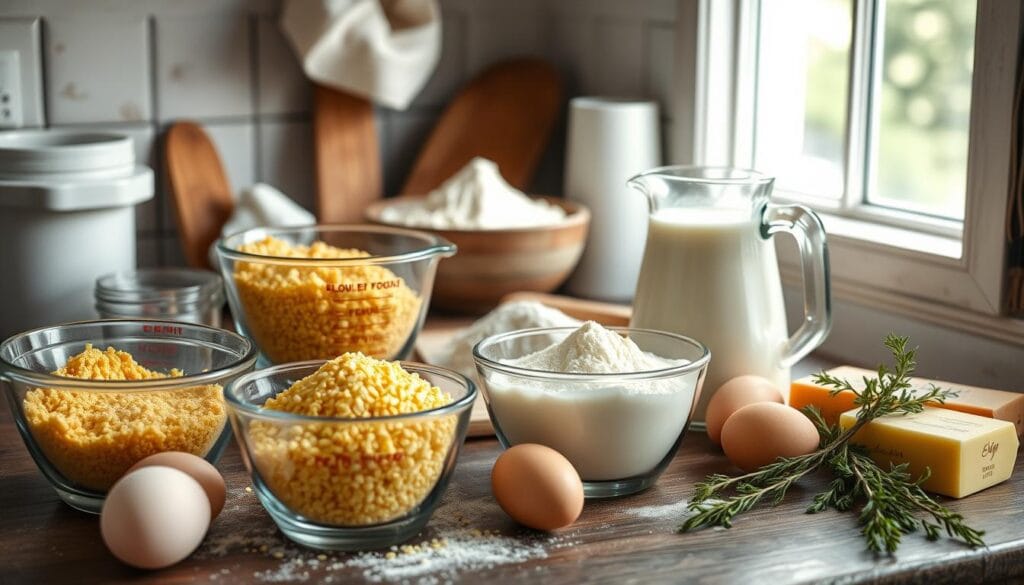
By following these steps, you’ll not only improve the flavor but also capture the true essence of Southern cornbread. Enjoy the journey as you learn to make this classic dish!
| Ingredient | Amount | Notes |
|---|---|---|
| Cornmeal | 1 cup | Stone-ground is preferred |
| All-purpose flour | ½ cup | For structure |
| Buttermilk | 1 cup | Can substitute with milk and vinegar |
| Melted butter | 2 tablespoons | Adds moisture and flavor |
| Sugar | 2 tablespoons (optional) | Adjust according to taste |
Common Mistakes to Avoid When Making a Southern Cornbread Recipe
Making the perfect Southern cornbread is more than just a recipe. It’s about paying attention to details to avoid common mistakes. These mistakes can affect the taste and texture of your cornbread. Knowing about overmixing, skipping preheating, and using the wrong cornmeal can make your baking better.
Overmixing and Its Effects on Texture
One big mistake is overmixing the batter. This adds too much air and gluten, making the cornbread dense and chewy. Instead, mix the ingredients gently until they just come together. This helps keep the cornbread light and fluffy.
Skipping Preheating the Skillet
Preheating the skillet is very important. A cold pan can make the cornbread hard to get out. Heat your cast iron skillet to 425°F (220°C) with some fat. This will help you get a crispy crust, a key part of good Southern cornbread.
Using the Wrong Cornmeal Type
Choosing the right cornmeal is key for flavor. Fine cornmeal is not as good as stone-ground types. Stone-ground cornmeal has a coarser texture and a richer taste, which is what Southern cornbread is all about. Trying different cornmeals can lead to different and exciting results.
| Mistake | Consequence | Solution |
|---|---|---|
| Overmixing the batter | Dense and chewy texture issues in cornbread | Fold ingredients gently until just combined |
| Skipping preheating skillet | Cold skillet affects the crust | Preheat skillet to 425°F (220°C) with fat |
| Using fine cornmeal | Less flavorful cornbread with inferior texture | Select stone-ground cornmeal for richness |
Pairing Suggestions for Your Southern Cornbread Recipe
Southern cornbread is known for its rich flavors. It’s a great addition to any meal. Its golden crisp edges make it perfect for classic southern dishes. It pairs well with hearty meals, adding to the enjoyment of your dining experience.
Classic Southern Meals That Complement Cornbread
Several dishes go well with cornbread:
- Chili
- Collard greens
- BBQ ribs or pulled pork
- Fried chicken
- Soup or stew
The savory taste of cornbread brings out the flavors of these meals. It’s comforting to have cornbread with chili or BBQ. It’s a combination that’s hard to resist.
Creative Ways to Use Leftover Cornbread
Leftover cornbread can be used in many ways:
- Croutons for salads or soups
- Stuffing for poultry dishes
- Crumble in buttermilk for a classic dessert
- Base for breakfast casseroles
Using leftover cornbread in new ways is a great idea. It reduces waste and lets you enjoy its flavor in different ways. These ideas help you make the most of your cornbread.
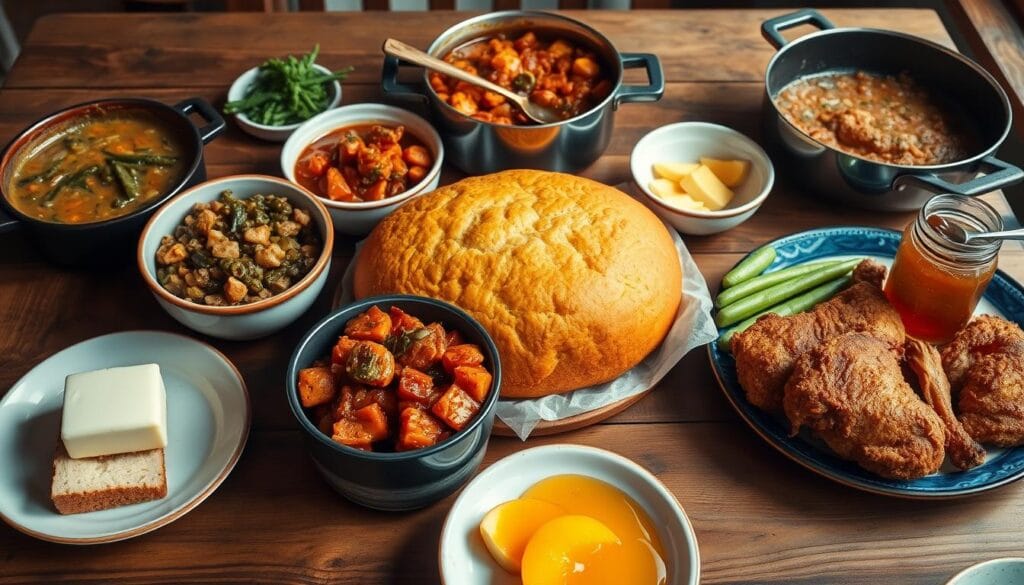
| Dish | Flavor Profile | Pairing Description |
|---|---|---|
| Chili | Spicy and hearty | Perfect with cornbread for a fulfilling meal. |
| Collard Greens | Earthy and savory | Balances well with the sweetness of cornbread. |
| BBQ Ribs | Smoky and rich | Complements the robust flavors of the meat. |
| Fried Chicken | Crispy and juicy | A classic pairing that is a southern favorite. |
| Soup or Stew | Warm and comforting | Enhances the satisfying experience of the dish. |
Storing and Reheating Your Southern Cornbread Recipe
Keeping cornbread fresh can make your meals better. Storing it right lets you enjoy its taste and texture for days. Whether it’s leftovers or a batch for a party, knowing how to keep it moist is key.
How to Keep Cornbread Fresh
For the best taste, wrap cornbread in a clean tea towel at room temperature for two days. If you need to keep it longer, the fridge is a good choice for up to a week. Don’t use plastic wrap, as it can make the cornbread soggy.
Best Methods for Reheating
The oven is the top choice for reheating cornbread. Heat it to 350°F and wrap each piece in foil. This method keeps it moist and crisp, just like when it’s fresh.
| Storage Method | Duration | Notes |
|---|---|---|
| Room Temperature (wrapped in a towel) | Up to 2 days | Best for immediate consumption. |
| Refrigerator | Up to 1 week | Use airtight container to prevent drying. |
| Freezer | Up to 3 months | Wrap well to avoid freezer burn. |
| Reheating in Oven | 10-15 minutes | Wrap in foil for moisture retention. |
By following these tips, you can enjoy cornbread’s deliciousness even after it’s been made.
FAQ
Southern cornbread is savory and focuses on the cornmeal’s earthy taste. It doesn’t have added sugars. Northern cornbread, on the other hand, is sweeter. It has a cake-like texture because of more flour and sugar.
In the South, it’s just called “cornbread.” But, different areas might call it something else, like “hoe cake” or “johnnycake,” based on what’s added.
Buttermilk is best for Southern cornbread. It adds a tangy taste and keeps it moist. Milk can be used, but it won’t give the same flavor.
Buttermilk, along with eggs, keeps cornbread moist and prevents it from crumbling. The right mix of ingredients is also important for the perfect texture.
A traditional Southern cornbread recipe needs stone-ground cornmeal, buttermilk, eggs, and bacon grease or butter. These ingredients give it its flavor and texture.
To get a crispy crust, preheat a cast iron skillet before adding the batter. The hot skillet creates a crunchy outside while keeping the inside moist.
Yes, you can make gluten-free cornbread. Use gluten-free cornmeal and adjust the recipe to avoid gluten in other ingredients.
Avoid overmixing the batter, not preheating the skillet, and using low-quality cornmeal. These mistakes can ruin the texture and taste of your cornbread.
Conclusion
Learning to make Southern cornbread is a special journey. It connects you to a beloved cooking tradition. By following this guide, you can make a perfect southern cornbread recipe. This recipe honors its history and meets today’s tastes.
Every step, from picking the right ingredients to perfecting your baking, is important. It helps you create this iconic dish.
When you start making southern cornbread, think about sharing it with loved ones. It’s great with a big meal or on its own. Your homemade cornbread will bring warmth and memories, making each bite special.
So, get ready, gather your ingredients, and dive in. With effort and love, you’ll become great at making southern cornbread. Your family and friends will love it for years.
